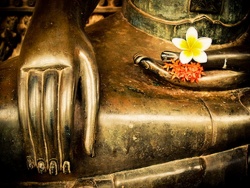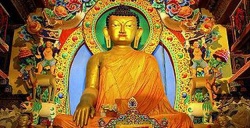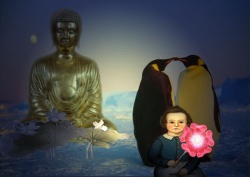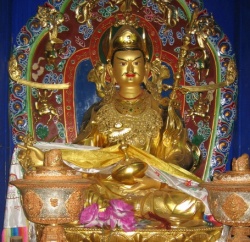Tantrayana
Tantrayana (Skt. tantrayāna; Tib. ཐེག་པ་རྒྱུད་, Wyl. theg pa rgyud), otherwise known as Mantrayana or the Vajrayana. It is the ‘Fruitional’ or ‘Resultant Vehicle’, because the path is no longer based on establishing the cause, but identifying directly with the fruition. Tantra begins with the view that the final attainment or result has been within the mind from the very beginning, but has been obscured by ignorance and adventitious defilements. Both sutra and tantra share the same ultimate goal of enlightenment. The greatest difference between them lies in the methods employed.
Tantrayana, a new tradition of Buddhism, started developing from the 7th century AD, and was radically different from the earlier traditions in
several important ways. Tantrayana, the Vehicle of the Text, is also known as Mantrayana, the Vehicle of Spells, or the Vajrayana, the Adamantine Vehicle. The Tantrayana or Vajrayana is actually a subset of the Mahayana Buddhism. The Tantrayana Buddhists themselves often classify their school as the final stage in the evolution of Indian Buddhist theorywhich they enumerate as Hinayana, Mahayana and Vajrayana.
The Tantrayana Buddhism facilitates an accelerated path to enlightenment to be achieved through the use of tantra techniques, which are practicalaids to spiritual development and esoteric transmission.
Whereas earlier schools of Buddhism provide ways to achieve Nirvana over the course of many lifetimes, the Tantrayana school makes full enlightenment or Buddhahood possible in a shorter time frame, or perhaps, in a single lifetime. While the goal of the Mahayana and Vajrayana is the attainment of Buddhahood, the goal for Tantrayana or Theravada practice is liberation from the cycle of rebirth in Nirvana.
The Speed Up Technique - Tantric Practices
The chief factor in the Vajrayana concept of Buddhism is tantric practices. The tantric path emphasises on the 'use of result as the path', which means that instead of placing full enlightenment as a goal far away in the future}}, one should try to identify with the enlightened body, speechand mind of a Buddha through symbolism and visualisation.
The Tantric Buddhism gives more importance to secrecy in order to avoid the practices from harming oneself and others without proper guidance. The tantric practices may at first appear as ritualistic nonsense, but can only be practiced on the basis of a thorough understanding of Buddhist philosophy and traditions.
The Tantric practices consist of:
i. Repetition of special ritual phrases or mantras.
ii. Use of an extensive vocabulary of visual aids like cosmic mandala diagrams which is used as a path to spiritual enlightenment.
iii. Use of numerous Yoga techniques.
iv. Use of ritual objects such as the vajra and bell (ghanta), hand-drum (damru), and many other symbolic tools and musical instruments.
v. Importance of a teacher (guru)-disciple (shishya) relationship (parampara).
vi. Use of specialised rituals rooted in the Vajrayana cosmology and beliefs.
Sexis symbolic in the Buddhist tantra, though one's sexualenergy can be transformed into a blissful consciousness to be directed towards achieving wisdom and enlightenment through the act of sexualintercourse. Vajrayana iconography treats sexualsymbolism commonly, where it basically represents the marriage of wisdom and compassion. Besides, the Tantrayana has also developed a rich and complex variety of meditation techniques.
Esoteric Transmission or Initiation
The very next speedup technique of the Tantrayana tradition is its esoteric transmission or initiation. Esoteric means the transmission of certain accelerating factors, which only occurs directly from teacher to student during an initiation and cannot be simply learned from a book.
Here, the techniques have no validity outside the teacher-student lineage. Since these techniques are highly effective, a practitioner can harm himself physicallyand mentally if he does not practice these techniques properly. Therefore, the practice should be kept secret outside the teacher-disciple relationship.
The Spread of Tantrayana
Vajrayana or Tantrayana exists in the form of two major sub-schools:
a. Tibetan Buddhism in Tibet, Bhutan, northern India}}, Nepal, south-west China, Mongolia and Kalmykia (the only Buddhist state of Europe}}.
b. Shingon Buddhism in Japan.
India
Tantrayana Alle Buddhistischen Tantrayana developed in Bengaland Orissa and flourished during the period of Buddhism's declinein India from 8th to 13th century AD. However, there are differing views regarding the origin of Tantrayana or Vajrayana. Some claim that it began in Udyana - the modernday Swat valleyin Pakistan}}, while the others say that it originated in the southern India. In the Tibetan tradition, it is claimed that the historical Shakyamuni Buddha taught tantra, but as these are 'secret' teachings outside the teacher/disciple relationship, they were penned down long after the Buddha's other teachings, known as Sutras.
The earliest texts related to Tantrayana appeared around the early 4th century. In northern India}}, the Nalanda university had by now became a centre for the development of Tantrayana theory}}. The Tantrayana practices led the other practices throughout the 11th century in India, but started declining after this period.
The Tantrayana Buddhism had mostly died out in India by the 13th century AD when its practices merged with Hinduism, and both tantric religions experienced pressure from the rising importance of Islam}}. By that time, the vast majority of the practices were also made available in Tibet, where they still remains.
A number of Tibetan exiles fled the oppressive anti-religious ruleof the Communist Chineseand to establish Tibetan Buddhist communities in the northern Indiain the 20th century. They still remain the primary followers of the Tantric Buddhism in India and the entire world.
China
The Tantrayana Buddhism reached northern China from India via the Silk route in the first half of the 7th century AD. It was during this period that the Buddhism was on its peak in China. The Tang capital at Chang'an (ModernXi'an}}) had become an important centre for the Buddhism studies and that is why, Tantrayana received great attention over here.
Japan
The emperor Kammuof Japan asked the monk Kukai to retrieve the latest Buddhist knowledge from China in 804 AD. The monk absorbed and synthesised the Tantrayana Buddhism into a version and took it to Japan, where he founded the Shingon school of Buddhism, which preached the basics and depth of Tantrayana.
Tibet and other Himalayan Kingdoms}}
The Indian saint, Padmasambhava travelled from Afghanistanto Tibet to bring Tantrayana Buddhism to Tibet on the request of the Tibetan king, and led to the foundation of the Nyingma school in Tibet. Later in the 11th and 12th century AD, another important transmission led to the lineage of Atisa, Marpa and Brogmi, which gave rise to other schools of Tibetan Buddhism - Kagyupa, Kadampa, Sakyapa and Gelukpa, the school of Dalai Lama.
Tantrayana; From the 7th century AD a new tradition of Buddhism began to develop that was in several important respects radically different from the earlier traditions.
Called Tantrayana, the Vehicle of the Text, this tradition is also known as Mantrayana,
the Vehicle of Spells, or the Vajrayana, the Adamantine Vehicle.
Tantrayana is characterized by an emphasison the value of magic and the propitiation of the bodhisattvas and gods in the quest for Nirvana. It has also developed a rich and complex variety of meditation techniques.
Tantrayana developed in Bengaland Orissa and flourished during the period of Buddhism's declinein India. (8th to 13th century AD). It had a significant following in Sri Lanka, Burma and Thailand where it was later replaced by Theravada. In Indonesiait was replaced by Islamand in both China and Japan it became moribund. It spread from India to Tibet from the 8th century onward, flourishing and developing there until its destruction in the 1950s. Today Tantrayana thrives amongst Tibetan refugees in India and has become perhaps the most successful Buddhist tradition in the West.
S.B.Dasgupta, An Introduction to Tantric Buddhism. Calcutta, 1950.
D. Snellgrove, Indo-Tibetan Buddhism. Boston, 1987.
see also: Vajrayana




